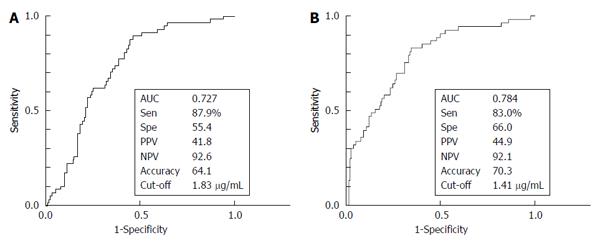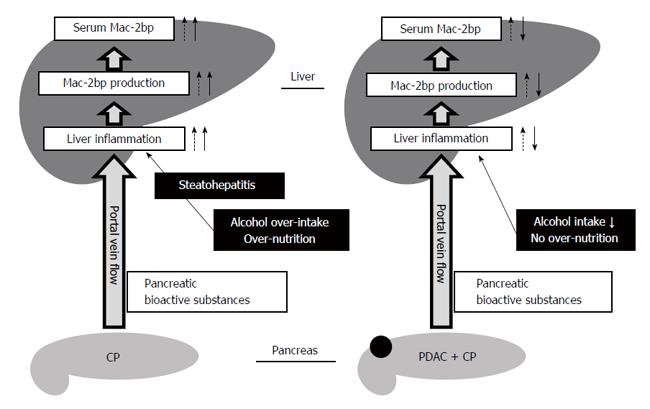Copyright
©The Author(s) 2016.
World J Gastroenterol. May 7, 2016; 22(17): 4403-4410
Published online May 7, 2016. doi: 10.3748/wjg.v22.i17.4403
Published online May 7, 2016. doi: 10.3748/wjg.v22.i17.4403
Figure 1 Serum Mac-2 binding protein levels were significantly elevated in chronic pancreatitis patients.
Serum Mac-2 binding protein (Mac-2bp) levels in each group [healthy volunteer (HV), chronic pancreatitis patients (CP), pancreatic ductal adenocarcinoma patients (PDAC)]. Each dot on the graph is one individual. Horizontal gray lines indicate the mean values of common log-transformed Mac-2bp in each group.
Figure 2 Serum Mac-2bp levels were useful for the discrimination of chronic pancreatitis patients from HV subjects and pancreatic ductal adenocarcinoma patients.
A: ROC curve for the discrimination of chronic pancreatitis (CP) patients from HV subjects; B: ROC curve for the discrimination of CP patients from pancreatic ductal adenocarcinoma (PDAC) patients. AUC: Area under the curve; Sen: Sensitivity; Spe: Specificity; PPV: Positive predictive value; NPV: Negative predictive value; Cut-off: Cut-off value.
Figure 3 Putative mechanism of serum Mac-2bp changes in chronic pancreatitis and pancreatic ductal adenocarcinoma.
In both chronic pancreatitis (CP) and pancreatic ductal adenocarcinoma (PDAC) patients, increased pancreatic bioactive substances produced in the pancreas flow into the liver through the portal vein and evoke inflammatory changes in the liver. This liver inflammation increases hepatic Mac-2bp production and serum Mac-2bp levels (Dotted arrows). Alcohol over-intake and/or relative over-nutrition induces steatohepatits in CP and further increases hepatic Mac-2bp production (left panel solid arrows). In contrast, the cessation of alcohol over-intake and no over-nutrition in PDAC would decrease hepatic Mac-2bp production and serum Mac-2bp levels would decrease in PDAC (right panel solid arrows).
- Citation: Maekawa T, Kamada Y, Ebisutani Y, Ueda M, Hata T, Kawamoto K, Takamatsu S, Mizutani K, Shimomura M, Sobajima T, Fujii H, Nakayama K, Nishino K, Yamada M, Kumada T, Ito T, Eguchi H, Nagano H, Miyoshi E. Serum Mac-2 binding protein is a novel biomarker for chronic pancreatitis. World J Gastroenterol 2016; 22(17): 4403-4410
- URL: https://www.wjgnet.com/1007-9327/full/v22/i17/4403.htm
- DOI: https://dx.doi.org/10.3748/wjg.v22.i17.4403











